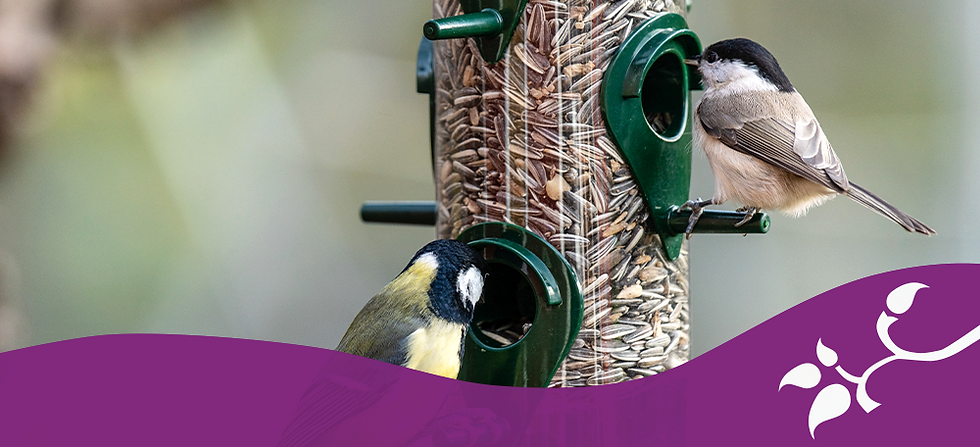How to Choose the Right Bird Feeder
- LVHG

- Dec 16, 2019
- 4 min read
Updated: Jun 12, 2024

There are so many great things we can do to beautify our landscape, but some of the most wonderful decorations are completely natural. Birds offer such a peaceful presence in the yard, decorating the landscape with their beautiful colors, attractive patterns, and graceful movements. If you struggle with making your yard a welcoming place for local wildlife, choosing the right bird feeder can go a long way.
CHOOSING THE RIGHT FEEDER
When it comes to bird feeders, there really is no wrong type. The type you choose, however, will determine what kinds of visitors flock to your garden. There are a few things to consider, such as what kinds of birds you want to attract, and what kind of feed you want to use before you find the right feeder for your garden. Even so, we suggest using a couple of different kinds to attract a wider variety of birds! Regardless of the type, there are still a few things to keep in mind when choosing a feeder: Choose a bird feeder that’s sturdy. In Allentown, we’re no stranger to harsh winds and winter storms, but this is also the time of year that birds rely on our feed and seed the most. Choose strong and sturdy structures to ensure they’ll withstand all of our seasons.

Make sure it will keep seeds dry. Since damp seeds are more likely to go rancid, choosing a feeder that keeps the birdfeed sheltered and dry in an airtight vessel is really useful. If you’re picking up a tray or ground feeder for larger birds, at least make sure the platform is made of a mesh material that will let water drain out.
Deter rodents and other animals. Some feeders are designed so that only birds can access the food, while others may be more inviting to squirrels, mice, raccoons, and other rodents and animals. Keep these pests away by using seed trays that aren’t heavy enough to hold the weight of pests, or use baffles to prevent them from being able to climb up the pole or branch to get to the food. Pick neutral-colored feeders. With the exception of hummingbirds, who are drawn to the color red, try to keep your food sources as neutral as possible. Birds are wary of bright colors and patterns, which will deter them from your garden. With natural colors and materials, they’ll feel right at home.

DIFFERENT TYPES OF BIRD FEEDERS
We carry many different kinds of feeders here at Lehigh Valley Home & Garden Center. Choose from metal, wooden, or plastic materials and all different shapes and sizes. Here are some of our most popular ones, but we’d love for you to visit us to see our entire selection!
House feeders: These sheltered houses are handy bird feeders in Allentown, as they protect the feed from harsh winds and weather. Fill this feeder with any kind of seed mix, and watch as the cardinals, finches, jays, and buntings perch on the base to snack. Squirrels can easily access these, so you may want to consider using safflower or thistle for feed or installing a squirrel baffle.
Tube bird feeders: These feeders are tube-shaped, with various ports for little birds like chickadees, finches, titmice, and sparrows to perch on. Larger birds can still get in on some of the action by eating seeds that have fallen to the bottom tray or on the ground. We suggest using a black-oil sunflower seed mix in hanging feeders—it’s enjoyed by many different kinds of species, bringing diversity to your landscape.
Platform feeders: These simple structures consist of a frame and a platform made of mesh or some other screening material that holds in the seed but allows rainwater to pass through. They can either be hung or laid on the ground. Platform feeders are perfect for larger birds like jays and cardinals, who might find the more delicate ones harder to eat from.
Ground feeders: Many large birds will actually avoid hanging feeders altogether and actually prefer to keep their search for food closer to the ground. To keep your yard inclusive, include a ground-level food source in your yard—ducks, grouse, doves, sparrows, cardinals, and juncos will thank you for it! White millet, cracked corn, and other bird seed mixes are favorites for these guys.
Suet feeders: Suet, which is made from beef fat, is an important source of fat and protein for many birds, especially during the winter when food sources are limited. Suet cakes, which often include other ingredients, like berries, nuts, and seeds, are usually held in metal cages that make it easily accessible for wild birds. It’s not too late to set out a suet feeder or two for the local birds this winter. While many creatures flock to suet, you might notice that woodpeckers and nuthatches will especially take a shine to it.

Hummingbird feeders: Hummingbird feeders differ from others because they’re filled with nectar rather than bird feed. The nectar is held in either a glass or plastic vessel, and dispensed through very tiny ports that hummingbirds access with their long, thin beaks. If you’re wondering how to get hummingbirds to come to your feeder, choose a red one—it’s their favorite color! You can easily make your own nectar; just dissolve 1 part sugar to 4 parts water—just remember to boil the water first to sterilize, and then let it cool.
Through December, your home is a blank canvas waiting for you to work your festive magic. There’s no better way to complete the Christmas experience than with real, fresh evergreens. Don’t wait any longer to embrace the holiday spirit—pick up your fresh Christmas evergreens at Lehigh Valley Home and Garden Center this week!








